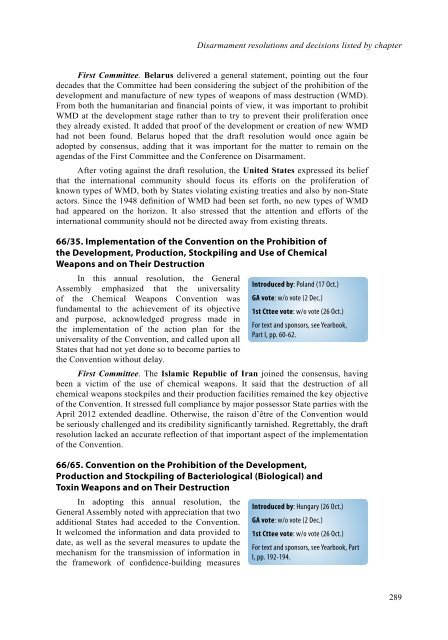DYB2011-Part-II-web
DYB2011-Part-II-web
DYB2011-Part-II-web
Create successful ePaper yourself
Turn your PDF publications into a flip-book with our unique Google optimized e-Paper software.
Disarmament resolutions and decisions listed by chapter<br />
First Committee. Belarus delivered a general statement, pointing out the four<br />
decades that the Committee had been considering the subject of the prohibition of the<br />
development and manufacture of new types of weapons of mass destruction (WMD).<br />
From both the humanitarian and financial points of view, it was important to prohibit<br />
WMD at the development stage rather than to try to prevent their proliferation once<br />
they already existed. It added that proof of the development or creation of new WMD<br />
had not been found. Belarus hoped that the draft resolution would once again be<br />
adopted by consensus, adding that it was important for the matter to remain on the<br />
agendas of the First Committee and the Conference on Disarmament.<br />
After voting against the draft resolution, the United States expressed its belief<br />
that the international community should focus its efforts on the proliferation of<br />
known types of WMD, both by States violating existing treaties and also by non-State<br />
actors. Since the 1948 definition of WMD had been set forth, no new types of WMD<br />
had appeared on the horizon. It also stressed that the attention and efforts of the<br />
international community should not be directed away from existing threats.<br />
66/35. Implementation of the Convention on the Prohibition of<br />
the Development, Production, Stockpiling and Use of Chemical<br />
Weapons and on Their Destruction<br />
In this annual resolution, the General<br />
Assembly emphasized that the universality<br />
of the Chemical Weapons Convention was<br />
fundamental to the achievement of its objective<br />
and purpose, acknowledged progress made in<br />
the implementation of the action plan for the<br />
universality of the Convention, and called upon all<br />
States that had not yet done so to become parties to<br />
the Convention without delay.<br />
First Committee. The Islamic Republic of Iran joined the consensus, having<br />
been a victim of the use of chemical weapons. It said that the destruction of all<br />
chemical weapons stockpiles and their production facilities remained the key objective<br />
of the Convention. It stressed full compliance by major possessor State parties with the<br />
April 2012 extended deadline. Otherwise, the raison d’être of the Convention would<br />
be seriously challenged and its credibility significantly tarnished. Regrettably, the draft<br />
resolution lacked an accurate reflection of that important aspect of the implementation<br />
of the Convention.<br />
66/65. Convention on the Prohibition of the Development,<br />
Production and Stockpiling of Bacteriological (Biological) and<br />
Toxin Weapons and on Their Destruction<br />
In adopting this annual resolution, the<br />
General Assembly noted with appreciation that two<br />
additional States had acceded to the Convention.<br />
It welcomed the information and data provided to<br />
date, as well as the several measures to update the<br />
mechanism for the transmission of information in<br />
the framework of confidence-building measures<br />
Introduced by: Poland (17 Oct.)<br />
GA vote: w/o vote (2 Dec.)<br />
1st Cttee vote: w/o vote (26 Oct.)<br />
For text and sponsors, see Yearbook,<br />
<strong>Part</strong> I, pp. 60-62.<br />
Introduced by: Hungary (26 Oct.)<br />
GA vote: w/o vote (2 Dec.)<br />
1st Cttee vote: w/o vote (26 Oct.)<br />
For text and sponsors, see Yearbook, <strong>Part</strong><br />
I, pp. 192-194.<br />
289


